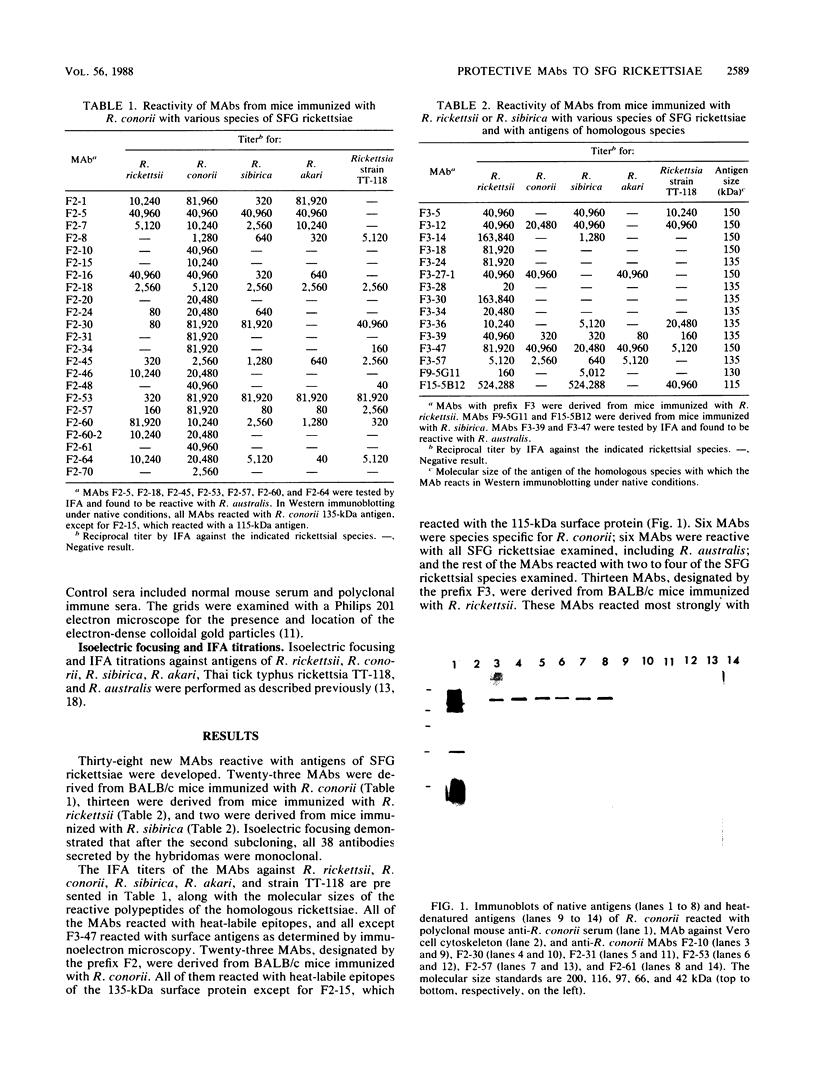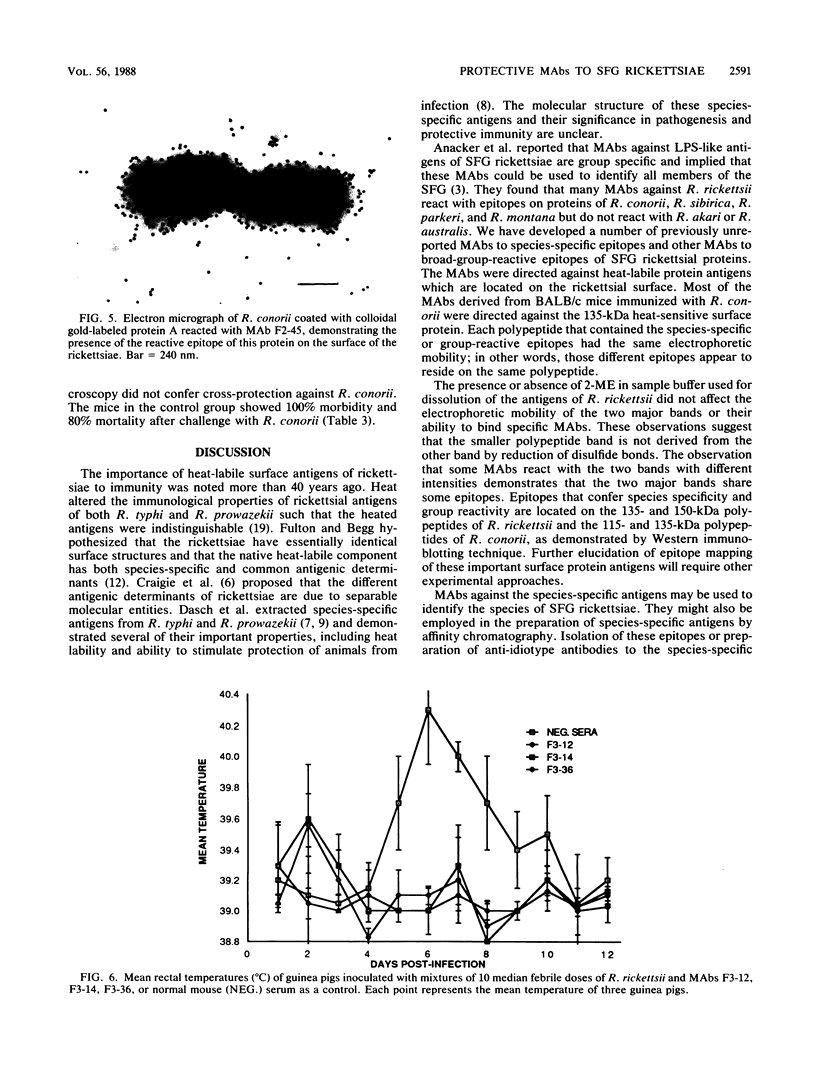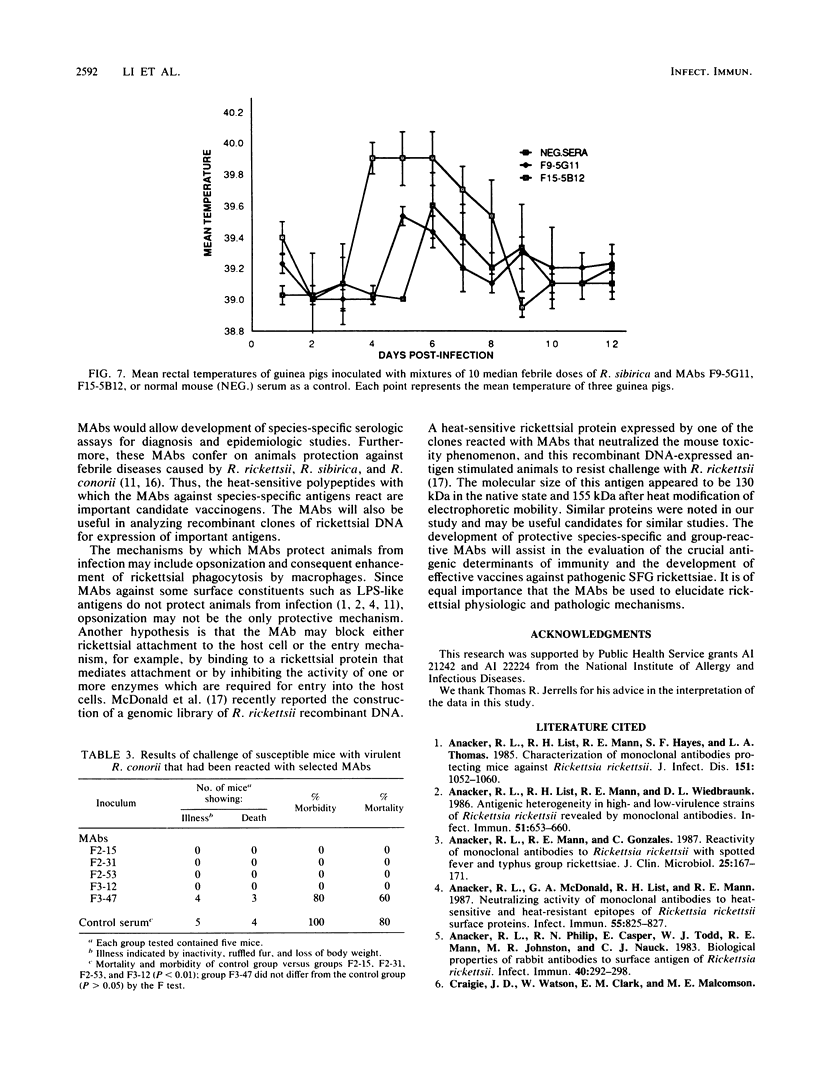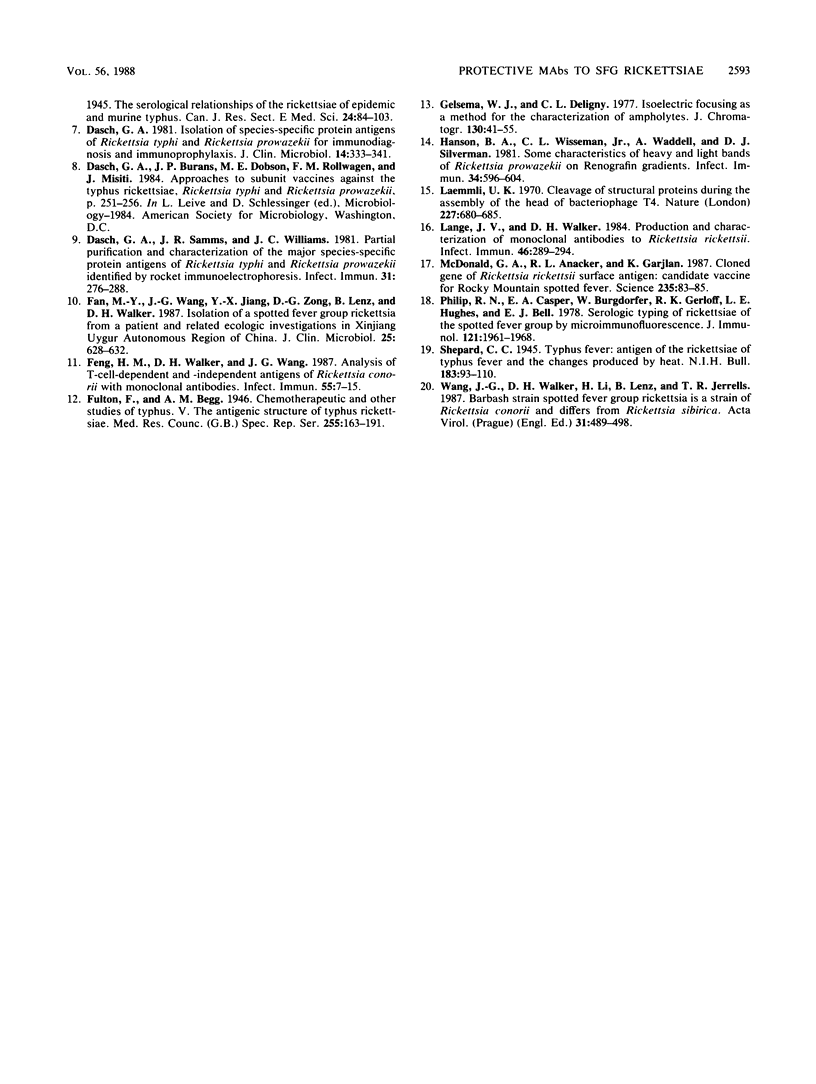Abstract
Thirty-eight monoclonal antibodies that have not been reported previously were developed from mice immunized with Rickettsia rickettsii, R. conorii, and R. sibirica. Western immunoblotting showed that these monoclonal antibodies are directed against heat-sensitive epitopes which are located on two major surface polypeptides with molecular sizes ranging from 115 to 150 kilodaltons. The detection of the two bands did not depend on the presence of 2-mercaptoethanol. Both bands were destroyed by treatment with proteinase K. Monoclonal antibodies examined by immunofluorescence assay reacted with epitopes that are species specific, group reactive, or shared among a smaller subset of species of spotted fever group rickettsiae. Nine of the monoclonal antibodies were evaluated for their ability to neutralize rickettsial infection and thus protect animals against disease caused by homologous species of rickettsiae. Treatment of rickettsiae with monoclonal antibodies F3-12, F3-14, and F3-36 completely protected guinea pigs against illness caused by the homologous organism R. rickettsii. Monoclonal antibodies F9-5G11 and F15-5B12, derived from mice immunized with R. sibirica, conferred partial protection by delaying the onset and shortening the duration of fever in guinea pigs inoculated with R. sibirica. Monoclonal antibodies F2-15, F2-31, F2-53, and F3-12 protected mice from a lethal infection with R. conorii. Heat-labile epitopes of spotted fever group rickettsial surface proteins are important candidate antigens for development of vaccines to confer protective immunity.
Full text
PDF






Images in this article
Selected References
These references are in PubMed. This may not be the complete list of references from this article.
- Anacker R. L., List R. H., Mann R. E., Hayes S. F., Thomas L. A. Characterization of monoclonal antibodies protecting mice against Rickettsia rickettsii. J Infect Dis. 1985 Jun;151(6):1052–1060. doi: 10.1093/infdis/151.6.1052. [DOI] [PubMed] [Google Scholar]
- Anacker R. L., List R. H., Mann R. E., Wiedbrauk D. L. Antigenic heterogeneity in high- and low-virulence strains of Rickettsia rickettsii revealed by monoclonal antibodies. Infect Immun. 1986 Feb;51(2):653–660. doi: 10.1128/iai.51.2.653-660.1986. [DOI] [PMC free article] [PubMed] [Google Scholar]
- Anacker R. L., Mann R. E., Gonzales C. Reactivity of monoclonal antibodies to Rickettsia rickettsii with spotted fever and typhus group rickettsiae. J Clin Microbiol. 1987 Jan;25(1):167–171. doi: 10.1128/jcm.25.1.167-171.1987. [DOI] [PMC free article] [PubMed] [Google Scholar]
- Anacker R. L., McDonald G. A., List R. H., Mann R. E. Neutralizing activity of monoclonal antibodies to heat-sensitive and heat-resistant epitopes of Rickettsia rickettsii surface proteins. Infect Immun. 1987 Mar;55(3):825–827. doi: 10.1128/iai.55.3.825-827.1987. [DOI] [PMC free article] [PubMed] [Google Scholar]
- Anacker R. L., Philip R. N., Casper E., Todd W. J., Mann R. E., Johnston M. R., Nauck C. J. Biological properties of rabbit antibodies to a surface antigen of Rickettsia rickettsii. Infect Immun. 1983 Apr;40(1):292–298. doi: 10.1128/iai.40.1.292-298.1983. [DOI] [PMC free article] [PubMed] [Google Scholar]
- Dasch G. A. Isolation of species-specific protein antigens of Rickettsia typhi and Rickettsia prowazekii for immunodiagnosis and immunoprophylaxis. J Clin Microbiol. 1981 Sep;14(3):333–341. doi: 10.1128/jcm.14.3.333-341.1981. [DOI] [PMC free article] [PubMed] [Google Scholar]
- Dasch G. A., Samms J. R., Williams J. C. Partial purification and characterization of the major species-specific protein antigens of Rickettsia typhi and Rickettsia prowazekii identified by rocket immunoelectrophoresis. Infect Immun. 1981 Jan;31(1):276–288. doi: 10.1128/iai.31.1.276-288.1981. [DOI] [PMC free article] [PubMed] [Google Scholar]
- Fan M. Y., Wang J. G., Jiang Y. X., Zong D. G., Lenz B., Walker D. H. Isolation of a spotted fever group rickettsia from a patient and related ecologic investigations in Xinjiang Uygur Autonomous Region of China. J Clin Microbiol. 1987 Apr;25(4):628–632. doi: 10.1128/jcm.25.4.628-632.1987. [DOI] [PMC free article] [PubMed] [Google Scholar]
- Feng H. M., Walker D. H., Wang J. G. Analysis of T-cell-dependent and -independent antigens of Rickettsia conorii with monoclonal antibodies. Infect Immun. 1987 Jan;55(1):7–15. doi: 10.1128/iai.55.1.7-15.1987. [DOI] [PMC free article] [PubMed] [Google Scholar]
- Hanson B. A., Wisseman C. L., Jr, Waddell A., Silverman D. J. Some characteristics of heavy and light bands of Rickettsia prowazekii on Renografin gradients. Infect Immun. 1981 Nov;34(2):596–604. doi: 10.1128/iai.34.2.596-604.1981. [DOI] [PMC free article] [PubMed] [Google Scholar]
- Laemmli U. K. Cleavage of structural proteins during the assembly of the head of bacteriophage T4. Nature. 1970 Aug 15;227(5259):680–685. doi: 10.1038/227680a0. [DOI] [PubMed] [Google Scholar]
- Lange J. V., Walker D. H. Production and characterization of monoclonal antibodies to Rickettsia rickettsii. Infect Immun. 1984 Nov;46(2):289–294. doi: 10.1128/iai.46.2.289-294.1984. [DOI] [PMC free article] [PubMed] [Google Scholar]
- McDonald G. A., Anacker R. L., Garjian K. Cloned gene of Rickettsia rickettsii surface antigen: candidate vaccine for Rocky Mountain spotted fever. Science. 1987 Jan 2;235(4784):83–85. doi: 10.1126/science.3099387. [DOI] [PubMed] [Google Scholar]
- Philip R. N., Casper E. A., Burgdorfer W., Gerloff R. K., Hughes L. E., Bell E. J. Serologic typing of rickettsiae of the spotted fever group by microimmunofluorescence. J Immunol. 1978 Nov;121(5):1961–1968. [PubMed] [Google Scholar]
- Wang J. G., Walker D. D., Li H., Lenz B., Jerrells T. R. Barbash strain spotted fever group rickettsia is a strain of Rickettsia conorii and differs from Rickettsia sibirica. Acta Virol. 1987 Nov;31(6):489–498. [PubMed] [Google Scholar]







